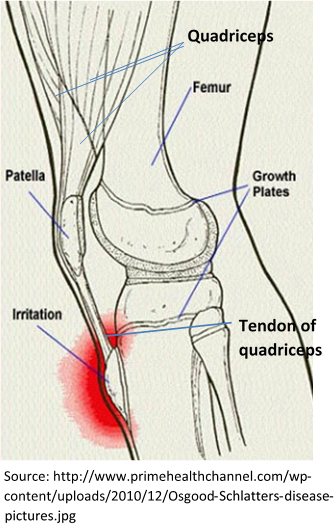Osgood Schlatters is a condition that causes knee pain in adolescents.
The quadriceps muscles all attach via a single tendon onto the tibia (shin bone) just below the knee joint (tibial tuberosity). Osgood Schlatters occurs when the quadriceps tendon pulls excessively on this attachment and so causes pain. In some cases, a bone flake may separate from the tibia itself and in some cases a bone callous or bump may form at the attachment. If a bump forms, it will be permanent but will become painless.
quadriceps tendon pulls excessively on this attachment and so causes pain. In some cases, a bone flake may separate from the tibia itself and in some cases a bone callous or bump may form at the attachment. If a bump forms, it will be permanent but will become painless.
Osgood Schlatters affects the immature skeleton and so is rarely found in adolescents over 16 years old. It is most commonly found in adolescents who participate in sports that involve strong quadriceps contraction such as when jumping or sprinting. It is also commonly associated with growth spurts as the bones grow more quickly than muscles so resulting in tight musculature and so a stronger pull on the structures where they insert. Osgood Schlatters is often precipitated by trauma to the area.
Osgood Schlatters is considered a self-limiting condition. This means that in time it will resolve itself as the skeletal system matures. Symptoms usually resolve within a few months but in some cases, may persist for up to two years. However, a podiatrist can help to manage the symptoms while they persist.
Treatment from home:
- Paracetamol (as directed) may help to manage the pain.
- Ibuprofen or another anti-inflammatory gel or medication (used as directed) may help reduce inflammation and pain.
- Place ice in a bag and wrap the bag in a tea towel. Use this to ice the area for 5-10 minutes to help manage pain. It may be especially useful before and after activity.
- Activity will aggravate the pain. Modify your activity levels temporarily to reduce your pain until symptoms resolve. You may not have to stop completely. Try having a few weeks of complete rest followed by gradual return to sport but reducing the number of trainings or games per week or the number of sports you play.
Treatment from your podiatrist may include:
- Advice about how to manage the pain from home.
- Advice on footwear or orthotic prescription if foot posture or function are thought to be increasing strain on the muscles around the knee.
- Advice on stretches or exercises for your quadriceps and hamstrings to reduce the pull and so irritation on the tibial tuberosity.
- In some persistent cases, an x-ray may be requested to visualise any bony flakes as in some cases, surgery may be required to remove the flakes to allow symptom resolution. The surgery is usually very successful.

Comments are closed.